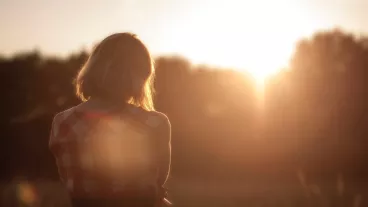Suicidality and help seeking in Australian young people
October 2020
Sonia Terhaag
Disclaimer
AIFS recognises that each of the numbers reported here represents an individual. AIFS acknowledges the devastating effects suicide and self-harm can have on individuals, their families, friends and communities.
This short article discusses suicide and presents material some people may find distressing. If you or someone you know is feeling depressed or suicidal, please contact one of the following services:
- In an emergency, call 000
- Lifeline: 13 11 14
- Kids Help Line (5–25 years): 1800 55 1800
- Suicide Call Back Service: 1300 659 467
- Beyond Blue: 1800 512 348
- MensLine Australia: 1300 789 978
Introduction
Suicide is the leading cause of death for young Australians and a national public health priority.1,2 Repeat suicide attempts increase the risk for dying by suicide;3 however, thoughts and behaviours related to suicide often go undetected and unreported. This short article presents the findings of Australian longitudinal research into suicidality and help-seeking behaviours, and provides strategies to guide practitioners working with young people.
What’s the research about?
Between ages 12–18, many young people first start self-injuring and may repeatedly do so.4 Recorded suicides among Australian children younger than 14 are rare but from 14 years onwards mental health issues, including self-injury, increase.5 Many young people who think about suicide or hurt themselves do not seek help,6 and more information is needed on their contact with formal and informal sources of help. Particular groups are known to be at higher risk for attempting suicide in Australia: girls; those from low socio-economic backgrounds; and Indigenous children.7,8,9 These groups may require more targeted prevention or intervention. This research identified how many young people struggle with suicidal thoughts or attempt suicide and help seeking for emotional difficulties.
Growing Up in Australia: The Longitudinal Study of Australian Children (LSAC) is a nationally representative cohort study that has followed over 10,000 children since birth (B cohort) and age 4–5 (K cohort) since 2004. Every two years, these children and their parents answer questions relating to their health and wellbeing, relationships and school experiences. Longitudinal data can help us gain better insights into how patterns of self-injury, including thoughts and behaviours, may or may not change over time, in order to identify how and where to best intervene.
What are the main findings?
Data from LSAC K cohort at ages 14–15 and 16–17 were used to understand patterns of suicidality. These young people reported on suicidal thoughts and behaviours experienced in the previous 12 months.
Occurrence of suicidal thoughts and behaviours over time
Approximately 17% had thought about taking their own life, 14% had planned a suicide, and around 10% had made a suicide attempt between the ages of 14 and 17. For those who had made an attempt, around two-thirds made one attempt (~65%) and one-third made two or more attempts over the two-year study period.
Of those who had made a suicide attempt in the previous year, 16% at ages 14–15 and 20% at ages 16–17 indicated the resulting injury, overdose or poisoning was treated by a doctor or nurse.
Help-seeking behaviour and intentions
Friends and parents were the most common sources of help for emotional problems among young people who had attempted suicide. Almost three-quarters reported seeking help from friends (74%) and nearly half from parents (49%). A small proportion reported seeking professional/specialised help (10% from a GP; 8% from a phone helpline). However, young people who had attempted suicide were less likely to seek help from their parents compared with those who hadn’t attempted suicide. Those who had attempted suicide reported they would be most likely to seek help from a friend in the next four weeks, on average, if they had emotional problems.
What do the findings mean?
Ages 14–17 is a period of vulnerability when almost a fifth of young people think about suicide. Effective, targeted and adjustable strategies are needed in settings where young people spend a lot of time and that are pivotal in their growth and development.
Many young people who experience suicidality may not seek help and, where they do, other young people are the most likely source of support for those experiencing emotional problems. Therefore, comprehensive mental health literacy education, including recognising signs someone may be struggling, and how to talk about those thoughts/feelings and seek help could be a successful strategy. This may reduce stigma around mental ill-health and suicidality. It may also increase their ability to appropriately respond to disclosures of suicidality and direct their friends to support services or resources. Resources are listed below to support practitioners in developing young people’s mental health literacy.
Schools are priority settings for suicide prevention efforts, as a connection point for young people and practitioners who support their mental health. Practitioners need training in recognising signs of suicidality, how to initiate and have conversations about suicide, and how to assess suicide risk. There is no evidence that suggests asking someone about suicide triggers suicidality.10,11 Resources are listed below to support practitioners, parents and young people to have these conversations, and to assess risk.
Most young people report their suicide attempt did not require medical treatment but it’s not known whether they still engaged with a health care provider post-attempt. Further understanding about young people’s health care engagement is needed, so any barriers can be addressed.
Related resources
Mental health literacy education
- headspace has developed school-specific resources, training and programs to assist educators and schools.
Assessing risk
- LivingWorks and Mental Health First Aid have developed comprehensive and tailored training for assessing suicide risk with young people.
Having conversations
- R U OK? and Conversations Matter have tips for how to start a conversation about mental health and wellbeing.
- Orygen, headspace and BeyondBlue have specific programs and guidelines for having these conversations with young people.
- LifeinMind Australia has a charter on best-practice language for talking about suicide.
- LivingWorks and Mental Health First Aid have developed comprehensive and tailored training for talking about suicide with young people.
- The World Health Organization has developed specific suicide prevention resources for primary health care workers, counsellors, and teachers and other school staff.
1 Australian Institute of Health and Welfare. (2019). Deaths in Australia: Leading causes of death. Canberra: AIHW. Retrieved from www.aihw.gov.au/reports/life-expectancy-death/deaths-in-australia/contents/leading-causes-of-death
2 Reifels, L., Ftanou, M., Krysinka, K., Machlin, A., Robinson, J., & Pirkis, J. (2017). Research priorities in suicide prevention. Retrieved from www.suicidepreventionaust.org/wp-content/uploads/2019/05/Research-priorities-Report-FINAL_2017-11-03_0.pdf
3 Christiansen, E., & Jensen, B. F. (2007). Risk of repetition of suicide attempt, suicide or all deaths after an episode of attempted suicide: A register-based survival analysis. Australian and New Zealand Journal of Psychiatry, 41(3), 257-265.
4 Lawrence, D., Johnson, S., Hafekost, J., Boterhoven De Haan, K., Sawyer, M., Ainley, J. et al. (2015). The mental health of children and adolescents: Report on the second Australian Child and Adolescent Survey of Mental Health and Wellbeing. Canberra: Department of Health. Retrieved from www1.health.gov.au/internet/main/publishing.nsf/Content/9DA8CA21306FE6EDCA257E2700016945/%24File/child2.pdf
5 Australian Bureau of Statistics. (2019). ABS Causes of Death 2018. Canberra: ABS. Retrieved from www.abs.gov.au/AUSSTATS/[email protected]/Lookup/3303.0Main+Features12018?OpenDocument
6 Michelmore, L., & Hindley, P. (2012). Help-seeking for suicidal thoughts and self-harm in young people: A systematic review. Suicide & Life-threatening Behavior, 42(5), 507-524. doi:10.1111/j.1943-278X.2012.00108.x
7 Daraganova, G. (2017). Self-harm and suicidal behaviour of young people aged 14-15 years old. In Australian Institute of Familiy Studies (Ed.), The Longitudinal Study of Australian Children Annual Statistical Report 2016. (pp. 119-144). Melbourne, Vic.: AIFS.
8 Perales, F., & Campbell, A. (2019). Early roots of sexual-orientation health disparities: Associations between sexual attraction, health and well-being in a national sample of Australian adolescents. Journal of Epidemiology and Community Health, 73(10), 954-962. doi:10.1136/jech-2018-211588
9 Priest, N., Paradies, Y., Gunthorpe, W., Cairney, S., & Sayers, S. (2011). Racism as a determinant of social and emotional wellbeing for Aboriginal Australian youth. The Medical Journal of Australia, 194, 546-550.
10 Mann J. J., Apter, A., Bertolote, J. et al. (2005). Suicide prevention strategies: A systematic review. Journal of the American Medical Association, 294(16), 2064–2074.
11 Gould, M. S., Marrocco, F. A., & Kleinman, M. (2005). Evaluating iatrogenic risk of youth suicide screening programs: A randomised controlled trial. Journal of the American Medical Association, 293(13), 1635–1643.
© GettyImages/Nikada
Related publications

Helplines, telephone and online counselling services for…
A list of national and state/territory helplines and telephone counselling services for children, young people and…
Read more
Family issues in suicide postvention
Looking at "postvention"for families - activities that can assist those bereaved by suicide to cope with what has…
Read more
Young Minds Matter: Mental disorders and risk-taking…
This article explores the high rates of smoking, alcohol consumption, and other risky behaviours among children and…
Read more